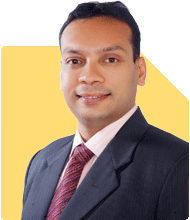Ramalingam Kalirajan |6501 Answers |Ask -Follow
Mutual Funds, Financial Planning Expert - Answered on Jul 06, 2024
He has an MBA in finance from the University of Madras and is a certified financial planner.
He is the director and chief financial planner at Holistic Investment, a Chennai-based firm that offers financial planning and wealth management advice.... more

Iam 50 years. Iam investing 1.75 in sip mf, planning to invest for next 10 years,and 20 k in post office R D. And 5lac per year. I have an ESOP worth 50 lac, PPF -30 lac,Epfo- 40 lac.TAta AIA WEALTH PRO PLAN FOR my daughter. Iam having F.D of 40 lacs. My question is How much do I need to invest to get the corpus of 10 crores in next ten years? Apart from these I have term and Health insurance for me and my family and a house to live in.
Understanding Your Current Financial Position
First, let's assess your current investments:
SIP in mutual funds: Rs. 1.75 lakh monthly
Post Office RD: Rs. 20,000 monthly
Annual investment: Rs. 5 lakh
ESOP: Rs. 50 lakh
PPF: Rs. 30 lakh
EPFO: Rs. 40 lakh
FD: Rs. 40 lakh
Tata AIA Wealth Pro Plan for your daughter
Term and health insurance for you and your family
House to live in
You have a well-diversified portfolio with a mix of equity, debt, and fixed-income instruments.
Calculating Your Goal
To accumulate Rs. 10 crore in the next 10 years, we'll consider the power of compounding and the expected returns from your investments. Let's break down the steps to achieve this goal.
Review and Optimize Existing Investments
Mutual Funds
SIPs are an excellent way to invest regularly and benefit from rupee cost averaging. Given your current SIP amount of Rs. 1.75 lakh per month, you are on a solid path. Consider the following mutual fund categories:
Equity Mutual Funds: These should form the core of your portfolio. Invest in a mix of large-cap, mid-cap, and small-cap funds. Equity funds typically offer higher returns, which is crucial for your long-term goal.
Debt Mutual Funds: These provide stability and reduce overall portfolio risk. Consider investing in short-term debt funds or corporate bond funds.
Hybrid Mutual Funds: These funds offer a balance between equity and debt. They are ideal for moderate risk-takers and provide diversified growth.
Post Office RD
Post Office RD is a safe investment but offers lower returns compared to equity and mutual funds. While it provides stability, consider if you can allocate more towards higher-return investments like mutual funds.
ESOPs
ESOPs are a valuable asset. Depending on your company's performance, they can provide significant returns. Monitor their performance and decide on the right time to exercise or sell them to maximize gains.
PPF and EPFO
Both PPF and EPFO are excellent for tax-saving and long-term growth. They offer guaranteed returns and should be continued for their benefits.
Fixed Deposits
FDs offer security but with lower returns. Consider moving a portion of your FD investments into mutual funds or other higher-yielding instruments to enhance growth.
Tata AIA Wealth Pro Plan
Review the performance and charges of this plan. ULIPs often have high charges which can impact returns. If the charges are high, consider surrendering and reinvesting the proceeds into mutual funds.
Calculating the Required Investment
To achieve a Rs. 10 crore corpus, you need a strategic investment approach. Let's assume different annual returns for various asset classes:
Equity Mutual Funds: 12-15% per annum
Debt Mutual Funds: 7-8% per annum
Fixed Deposits and RD: 5-6% per annum
PPF and EPFO: 7-8% per annum
Given these returns, we'll determine how much you need to invest additionally to reach your goal.
Power of Compounding
Compounding is crucial in wealth creation. The earlier and more consistently you invest, the greater the compounding effect. Here's a breakdown of how different investments can grow:
SIPs in Mutual Funds
Your Rs. 1.75 lakh monthly SIP in equity mutual funds can grow significantly over 10 years with an average return of 12-15%. The power of compounding will exponentially increase your corpus.
Post Office RD
Your Rs. 20,000 monthly RD will provide stable but lower returns. While it's a safe option, consider increasing your allocation to equity funds for higher growth.
Annual Lump Sum Investment
Investing Rs. 5 lakh annually can significantly boost your corpus. Allocate this amount to equity and hybrid mutual funds for optimal growth.
Systematic Investment Plan (SIP)
SIPs are a disciplined way to invest in mutual funds. They allow you to invest a fixed amount regularly, taking advantage of rupee cost averaging. Here's how to optimize your SIP strategy:
Increase SIP Contributions
Start with your current SIP amount and gradually increase it as your income grows. This will maximize the compounding effect and help you reach your goal faster.
Diversify Across Fund Categories
Invest in a mix of large-cap, mid-cap, and small-cap funds to diversify risk and enhance returns. Consider sector-specific funds for additional growth potential.
Asset Allocation and Diversification
A well-diversified portfolio balances risk and return. Here's a suggested asset allocation:
Equity Mutual Funds: 60-70%
Debt Mutual Funds: 10-20%
Fixed Income (PPF, EPFO, FD, RD): 20-30%
Regularly review and rebalance your portfolio to maintain this allocation.
Risk Management and Contingency Planning
Adequate insurance coverage and an emergency fund are essential. Ensure you have term life insurance and health insurance to protect your family's financial future. Maintain an emergency fund covering 6-12 months of expenses in a liquid and safe instrument like a high-interest savings account or liquid mutual fund.
Tax Planning
Optimize your investments for tax efficiency. Utilize tax-saving instruments like PPF, ELSS, and life insurance premiums under Section 80C. Equity investments held for more than a year benefit from long-term capital gains tax, which is lower than short-term capital gains tax.
Equity Linked Savings Schemes (ELSS)
ELSS funds offer tax benefits under Section 80C and have a lock-in period of three years. They are excellent for long-term wealth creation and tax planning.
Final Insights
Reaching a Rs. 10 crore corpus in 10 years is an ambitious goal, but with disciplined and strategic investing, it's achievable. Here's a summary of your investment strategy:
Increase SIP Contributions: Gradually increase your SIP amount as your income grows. Focus on equity mutual funds for higher returns.
Optimize Existing Investments: Review and potentially reallocate your RD and FD investments into higher-return instruments like equity and hybrid mutual funds.
Utilize Annual Lump Sum Investments: Continue investing Rs. 5 lakh annually in a mix of equity and hybrid mutual funds.
Diversify and Rebalance: Maintain a diversified portfolio with a mix of equity, debt, and fixed-income instruments. Regularly review and rebalance to stay aligned with your goals.
Maximize Tax Efficiency: Utilize tax-saving instruments and plan your investments to minimize tax liabilities.
Risk Management: Ensure adequate term and health insurance coverage. Maintain an emergency fund for financial stability.
By following these steps, you can work towards achieving your Rs. 10 crore goal within the next 10 years. Stay disciplined, review your investments regularly, and adjust your strategy as needed.
Best Regards,
K. Ramalingam, MBA, CFP,
Chief Financial Planner,
www.holisticinvestment.in
You may like to see similar questions and answers below
Nikunj Saraf | Answer |Ask -Follow
Mutual Funds Expert - Answered on Nov 11, 2022
Ramalingam Kalirajan |6501 Answers |Ask -Follow
Mutual Funds, Financial Planning Expert - Answered on Jul 19, 2024
Ramalingam Kalirajan |6501 Answers |Ask -Follow
Mutual Funds, Financial Planning Expert - Answered on Jun 18, 2024
Ramalingam Kalirajan |6501 Answers |Ask -Follow
Mutual Funds, Financial Planning Expert - Answered on Jul 23, 2024
Dr Dipankar Dutta |653 Answers |Ask -Follow
Tech Careers and Skill Development Expert - Answered on Oct 04, 2024
Krishna Kumar |377 Answers |Ask -Follow
Workplace Expert - Answered on Oct 04, 2024
Krishna Kumar |377 Answers |Ask -Follow
Workplace Expert - Answered on Oct 04, 2024
Krishna Kumar |377 Answers |Ask -Follow
Workplace Expert - Answered on Oct 04, 2024
Krishna Kumar |377 Answers |Ask -Follow
Workplace Expert - Answered on Oct 04, 2024
Krishna Kumar |377 Answers |Ask -Follow
Workplace Expert - Answered on Oct 04, 2024
Krishna Kumar |377 Answers |Ask -Follow
Workplace Expert - Answered on Oct 04, 2024
Krishna Kumar |377 Answers |Ask -Follow
Workplace Expert - Answered on Oct 04, 2024
Krishna Kumar |377 Answers |Ask -Follow
Workplace Expert - Answered on Oct 04, 2024
Krishna Kumar |377 Answers |Ask -Follow
Workplace Expert - Answered on Oct 04, 2024











.jpg)












